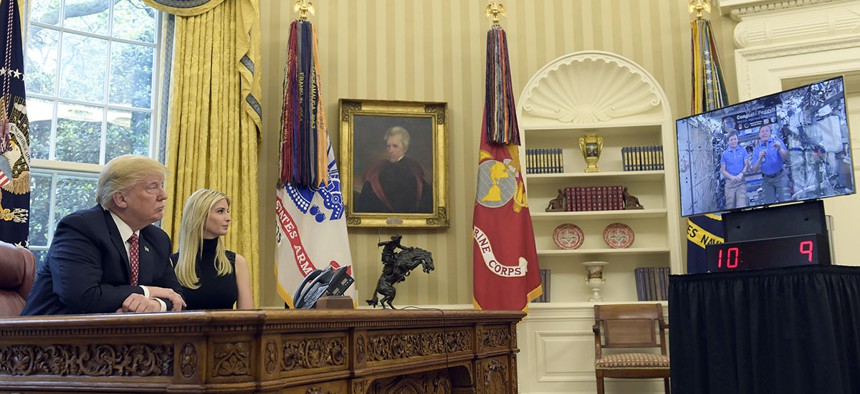Could Donald Trump Really Send Astronauts to Mars in the Next Seven Years?

President Donald Trump, accompanied by his daughter Ivanka Trump, talks via video conference with International Space Station Commander Peggy Whitson. Susan Walsh/AP
NASA hopes to make the trip to Mars by the early 2030s.
Donald Trump got on the phone yesterday to congratulate veteran astronaut Peggy Whitson, who recently arrived at the International Space Station and, having spent 534 days in space including two previous tours on the orbital lab, broke the record for the longest overall time spent in space by an American.
NASA’s research at the station includes preparing humans for long-duration space voyages, like the trip to Mars the US space agency hopes to bring to fruition in the early 2030s, Whitson said during the call.
“Well, we want to try and do it during my first term or, at worst, during my second term,” Trump replied. “So we’ll have to speed that up a little bit, okay?”
The remark might have been a joke about a politician’s priorities, but you can never tell with Trump, and minutes later he noted that he is “very proud that I just signed a bill committing NASA to the aim of sending America astronauts to Mars, so we’ll do that…I think we’ll do it a lot sooner than we’re even thinking.”
That bill, however, didn’t change NASA’s pace toward Mars, which is deliberate at best. Marrying the costs of maintaining ISS to the no-risk-tolerated design strategy for a new deep-space rocket and spacecraft has left the agency with a slow path toward Martian exploration. While the Trump administration has pushed NASA to consider adding humans to test flights of its new space exploration system, it’s only likely to fly twice before 2022, when Trump will face reelection, and neither mission will aim for Mars.
Even if NASA has a deep-space rocket and spacecraft ready by the second term of a Trump administration, the agency still lacks a space habitat to transport astronauts over long distances, or a craft to get them down to Mars and back again. Lockheed Martin, the contractor behind NASA’s new space capsule, has a plan to have all the necessaries ready—in time for a 2028 departure, four years after Trump hands over the White House to president Kamala Harris.
NASA, at present, is waiting for more guidance from the new administration, on key questions ranging from who will lead NASA to the make-up and powers of a new space council, led by vice president Mike Pence, that will coordinate space policy across the administration.
The Trump administration could decide to accelerate the NASA Mars program by pouring money into the program, but that seems unlikely at a time when the president is contemplating a massive corporate tax cut and spending increases on the military. The Apollo program only took eight years to get Americans to the moon, but the entire program cost the equivalent of more than $100 billion today, or five times NASA’s current annual budget; at the program’s peak, in 1966, 2% of federal spending went toward the moon mission.
But there is another, cheaper, riskier way, and Trump might know what it is.
“Many American entrepreneurs are racing into space,” the president said today. “I have many friends that are so excited about space. They want to get involved in space from the standpoint of entrepreneurship and business.”
The friends Trump is referring to likely include Peter Thiel, the tech investor and prominent Trump backer, and Elon Musk, the founder of SpaceX and occasional outside adviser to the new administration. Musk has not been shy about his interest in launching human expeditions to Mars, culminating in a presentation at last year’s International Astronautical Congress laying out the vision for a transport system to make such voyages possible. Most important for Trump: Musk envisions trips beginning in 2020, within the president’s ideal timeline.
SpaceX’s proposed system, including massive re-usable rockets, on-orbit refueling, and propellant manufacturing on Mars, will require significant investment, with Musk offering a minimum cost of $10 billion. That is roughly half of NASA’s annual budget, and critics suggest that he is underestimating the cost of the project and overestimating the speed at which it could get done. But that price-tag is still less than the nearly $12 billion that NASA has estimated the second flight alone of its new spacecraft will cost.
Besides lingering questions about the effects of deep-space radiation on humans, the least-developed part of Musk’s plan is funding, as he himself concedes. The financing could come from SpaceX revenues, other billionaires, or even foreign sources, like the UAE’s sovereign wealth fund. NASA funding a Mars mission through a public-private partnership would mean a major policy shift for the agency, which holds exploration to be its sacrosanct mission, and a bruising battle with traditional NASA contractors and their backers in Congress. But it could be the fastest way to the red planet.
More likely is the kind of pathway many at NASA and in the commercial space industry expect: Another decade of research and technology development around the Earth and the moon to iron out the risks before a future Martian voyage sets off. Such work is likely to include public-private partnerships, international collaborations, and perhaps even straight-up commercial plays.
“Through the signing of the NASA Authorization Act, the President has already taken steps to refocus NASA on its core mission of exploration,” a White House official said when asked how to interpret the president’s remarks on Mars. “He is excited about the budding commercial space flight industry, and wants to encourage competition and innovation in that area.”



